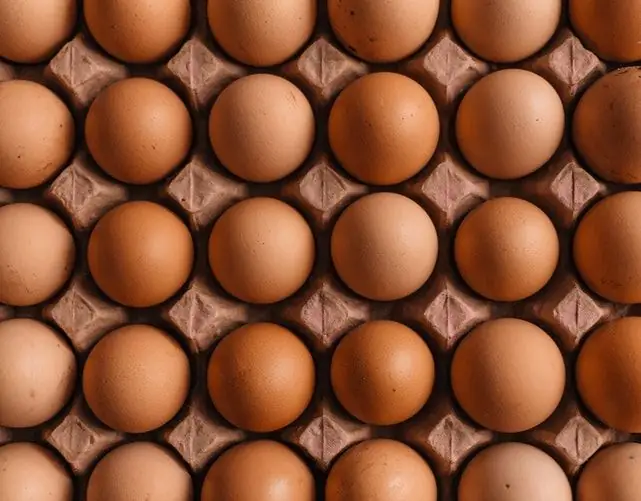2026 Author: Isabella Gilson | [email protected]. Last modified: 2025-01-23 12:50:39
Chicken eggs are certainly a valuable product that is included in many dishes, nutritious and inexpensive. They are also recognized by many doctors as dietary, although recently this statement has been criticized. However, eggs can also be dangerous. Cleanliness in the chicken coop is a relative concept, and the shell carries a great many types of infection. Therefore, in all catering establishments, hospitals, children's institutions, etc., processing the egg before it is cooked is mandatory. And in a good way, it would be worth making it as such in home cooking.

Preliminary action
Before the actual egg processing begins, the products need to be sorted. All cracked specimens are discarded; at catering establishments, they are subject to immediate disposal. At home, you canput them in scrambled eggs - but only immediately, they are not subject to storage.
Second rule: don't keep eggs in the same packaging they came in. In the catering departments, they are immediately laid out in containers labeled "for processing eggs." At home, it would be wise to follow this rule: in any refrigerator on the door there is a dedicated shelf with cassettes for eggs.

Basic egg handling instructions
Product disinfection occurs in several stages.
- If the shell is heavily soiled, the eggs are soaked in a container filled with approved solutions. These include a half-percent soda ash solution and 0.2 percent caustic. It is worth noting that there are disputes about the admissibility of the latter and it is better to resort to an unconditionally safe means.
- When the dirt softens, the eggs are cleaned with non-hard brushes (you can use a clean dishwashing sponge at home) and washed with running tap water.
- Further, the processing of eggs according to SanPiN involves soaking them in a disinfectant. Its concentration, exposure time and temperature of the solution depend on the selected agent.
- The last step is washing. It is carried out in a separate bath, running warm water and not less than a quarter of an hour.
Disinfected eggs are laid out in containers with an indication that they contain already processed products, and put away for storage. Employees who took part in the processing are instructed not only to wash their hands, but also to treat with skinantiseptic, as well as a change of clothes.

Two processing methods
In catering, eggs can be washed and disinfected both mechanically and manually. The first is more technologically advanced: a conveyor is installed for it, in the cells of which the eggs are placed. In it, they are subjected to automated action. First, the products are cleaned with nylon brushes installed in the apparatus, then the eggs are passed through the “shower”, then they are immersed in the solution right in the cassettes and again go through rinsing.
Manual egg processing requires the installation of two tubs. After cleaning with brushes, they are used in turn. It is clear that this method is more laborious, but does not require investment in equipment. For small cafes and preschools, it is more practical and economical.

Acceptable disinfectants
Sanitary instructions allow the use of a range of compounds. The list of the most popular disinfectants includes the following:
- 4% Deson. Disinfection lasts 20 minutes.
- 1% Optimax. The duration of exposure is a quarter of an hour.
- 7% Polydex. Eggs are immersed for 15-20 minutes.
- 0, 1% Eco-50M, bookmark time - half an hour.
- 2% Nika-2, also half an hour.
In all solutions in which eggs are processed, a temperature of 45-50 degrees is maintained. The shelf life of the solutions is also different, and the compositions change in accordance with the appliedinstructions.
Nika-2 and its advantages
All proposed disinfectants have their advantages and disadvantages. Compared to both, Nika-2 has several winning sides.
- The product can be used not only to disinfect eggs, but also to treat equipment and surfaces.
- "Nika-2" is washed off with particular ease.
- The antimicrobial effect is the highest and covers a wide range of harmful bacteria.
- Antiallergenic, which is especially important when working with children.
- Provides an antistatic effect, that is, it prevents the re-settlement of dust and grease particles during storage of eggs.
- Explosion and fireproof.
- Ordinary tap water is fine for preparing the solution.
An additional bonus is that the product is not aggressive to the materials that make up kitchen equipment: rubber seals, stainless steel, enamels, plastic, etc.

Basic rules of use
When the Nika-2 eggs are processed, a number of points should be taken into account so that its effect is as pronounced as possible, and its use is safe for people. First, you need to ensure that the product does not mix with other chemicals, primarily with acids. Secondly, the solutions are prepared exclusively in a ventilated room (the washing room is necessarily equipped with supply and exhaust ventilation). Thirdly, when working with the drug, it is strictly forbidden to smoke in the same room,eat and drink - vapors of the product can enter the body, despite the fact that its volatility is not too high.
If "Nika-2" gets on the skin (especially in concentrated form), it is urgent to wash the affected area under running water. The concentrate can be pre-neutralized with food vinegar.
Recommended:
Which eggs are best? C1 or C0? Types of eggs and their classification

Eggs are probably one of the most versatile foods known to man. They can be cooked and seasoned in hundreds of different ways. To decide which eggs are better, C1 or C0, it is worth understanding what egg categories are and how they are assigned
Is there salmonella in quail eggs? Myths about quail eggs

Quail eggs are no longer a curiosity that many bypassed in stores. This product is practically bought on a par with chicken and is used in the preparation of many dishes. In addition, disputes about which type of eggs - quail or chicken - are more useful do not stop. In connection with the rooting of this product on the shelves of Russian markets, the question is whether it is possible to become infected with salmonellosis from quail eggs. Is this a myth or true? Learn from the article
Raw vegetables: useful properties, storage, processing

Everyone knows about the benefits of vegetables. There is not a single concept of nutrition that would prohibit their use. The keto diet, the Dukan diet, the Minus 60 system, and other popular weight loss programs practically do not limit the consumption of vegetables. It is a valuable source of fiber, vitamins and micronutrients. What else are raw vegetables useful for and how best to eat them?
"Piano in the bushes" - recommended for a visit

The article describes the advantages of the "Royal in the bushes" - a restaurant located in Krasnoyarsk and having a lot of positive feedback from visitors
Nutrition for type 2 diabetes: sample menu and recommended foods

Type 2 diabetes is a metabolic disease that has become a real epidemic in the modern world. It is often caused by dietary errors and obesity, so the selection of foods for patients with diabetes is a key factor in good he alth

